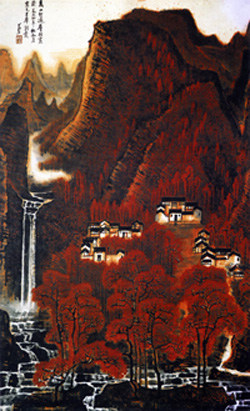|
 |
|
MASTERPIECE: Li Keran's painting Mountains in Red is sold for $46.33 million at an auction in Beijing on June 3 (FILE) |
Buying art can be as prestigious as owning a downtown luxury apartment, a high-powered Mercedes-Benz or other pricy toys the rich use to fight ennui and establish status. In China's modern times, the main difference between a fancy limousine and a painting is that the limousine is certain to decline in value from the day it's driven off the lot.
On the evening of June 3, Li Keran's painting Mountains in Red set a new record in China's spring auction season when it was sold for a whopping 293.25 million yuan ($46.33 million) in Beijing. Li (1907-89) was a famous modern Chinese painter born in Xuzhou of east China's Jiangsu Province.
The global art market has seen new highs in revenue recently, following the turbulence of the world economy. A major reason was the emergence of classic and outstanding works, said Xi Mu, Deputy Director of Chinese Institute of Art Market.
Painting at a price
China has caught up to the international art scene. According to statistics from the Art Market Research Center, the total trade volume of China's art auction market (including the Chinese mainland, Taiwan, Hong Kong and Macao) reached 97.45 billion yuan ($15.4 billion) in 2011. It was an opulent increase of 65.5 percent compared to the previous year's 58.875 billion yuan ($9.3 billion). Modern fine art sold at public auctions in 2011 on the mainland covered 41 percent of the global art market, making China the most important modern art market worldwide.
Despite the impressive 425 million yuan ($67.1 million) earned by Eagle Standing on Pine Tree painted by Qi Baishi (1864-1957) in 2011, the most important category of China's auction art market remains classical Chinese painting with a 61-percent share. Oil paintings and contemporary art are playing a minor role in the auction market, contributing 8 percent to the total trade volume. Porcelain and miscellaneous items held a share of 31 percent of the overall volume.
On April 4, Hong Kong Sotheby's Auction House put Ru-Kiln Sunflower of Celeste Blue Glaze from the Northern Song Dynasty (960-1127) up for auction. It was sold for HK$207.86 million ($26.8 million), creating a new international auction record for porcelain from this period of Chinese history.
Auction powerhouses Sotheby's and Christie's are not allowed to operate on the mainland, though they regularly hold exhibits at luxury hotels in Beijing and Shanghai. Buyers are invited to view the wares, but must order them from Hong Kong, Macao or any of their other outlets spread over the world. Bulky art catalogues in Mandarin are now standard in upscale locales, while Sotheby's recently staged its first show in Chengdu of central China's Sichuan Province.
Finance meets art
The target demographic is easy to distinguish: They are the 1.1 million millionaires living on the mainland. Whenever an auction on Chinese art opens in London, New York or Paris, a mass of Chinese buyers starts bidding in person or via phone with very discrete go-betweens.
Urs Meile, an art dealer from Switzerland and one of the early arrivals to China's art market, once warned New York art critic Barbara Pollack about the special characteristics of the emerging art market in China, calling it the "wild, wild East." The term appeared in Pollack's lively account of An American Art Critic's Adventures in China.
Pollack observed peculiarities in how dealers and artists interact in China. Exclusive marketing doesn't exist, for instance, and for a short period of time, a dealer may be granted the right to act as the artist's exclusive representative. In a very volatile market, a dealer might earn a fortune rapidly by reselling a work of art, without any obligation to share the money with the artist.
| 